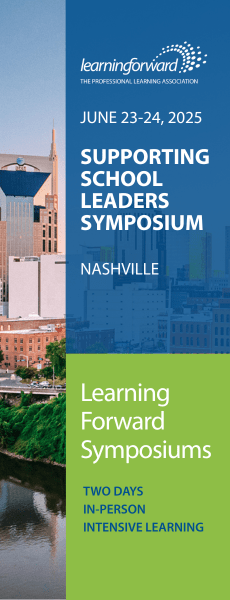From Theory To Action
Learning shifts into high gear with structured supports
By Learning Forward
October 2014
Read the remaining content with membership access. Join or log in below to continue.
Sed ut perspiciatis unde omnis iste natus error sit voluptatem accusantium doloremque laudantium, totam rem aperiam, eaque ipsa quae ab illo inventore veritatis et quasi architecto beatae vitae dicta sunt explicabo. Nemo enim ipsam voluptatem quia voluptas sit aspernatur aut odit aut fugit, sed quia consequuntur magni dolores eos qui ratione voluptatem sequi nesciunt. Neque porro quisquam est, qui dolorem ipsum quia dolor sit amet, consectetur, adipisci velit, sed quia non numquam eius modi tempora incidunt ut labore et dolore magnam aliquam quaerat voluptatem.
| La Follette High School problem of practiceSchool data show that students struggle to think, read, and write critically and that disparity exists in students’ engagement and academic progress. Community-school data identify the need for continuous staff collaboration to design and assess standards-based tasks and supports to shift the cognitive load to students. |
| La Follette High School theory of actionIf all staff collaborate purposefully to: • Design standards-based tasks and supports; • Shift the cognitive load so that students think, read, and write critically; and • Measure and reflect on the impact of their actions on student learning; Then all students will become more engaged, collaborative, and independent critical thinkers, readers, and writers whose formative and summative assessment results reflect growth for career, college, and community readiness. |
La Folette High School Teams
| School-based leadership team | Instructional leadership team | Instructional coaching team | Innovation team | |
| Members | Principal, 4 assistant principals, 2 instructional coaches, 6 department chairs, school psychologist. | Principal, 2 instructional coaches, 15 (all) department chairs. | Principal, 4 assistant principals, 2 instructional coaches. | 2 instructional coaches, assistant principal, social worker, speech/language clinician, 8 teachers. |
| Focus | Support and monitor implementation of theory of action. | Department leadership, instructional improvement, and student learning. | Instructional improvement and student learning. | Instructional improvement and student learning. |
| Actions | Data-informed decision making and progress monitoring. | Facilitating professional learning communities during professional learning time. | Instructional rounds, collaborative classroom visits, classroom walk-throughs. | Implementing classroom practices consistent with theory of action and leadership for professional learning communities during professional learning time. |
| Meeting frequency | Bimonthly and biannual half-days. | Bimonthly and quarterly half-days. | Monthly. | Biannual half-days. |
3 Collaborative Professional Learning Experiences
| Instructional rounds | Collaborative classroom visits | Classroom walk-throughs | |
| Length of visit | 25 minutes. | 45 minutes. | 10-15 minutes. |
| Who | 20-25 school colleagues and external partners (3-4 per observation) | 1 administrator, 1 instructional coach, and 1-3 teachers. | 1 instructional coaching team member. |
| Outcomes | Schoolwide themes. | Classroom noticings and wonderings. | Classroom noticings and wonderings. |
| how Outcomes are shared | Group discussion of schoolwide themes. | Preconference and post-conference discussions with classroom teacher. | Schoolwide walk-through form emailed to teacher with actionable, specific feedback. |
9th Graders Term 4 Course Failures

References
Brown, K.M., Benkovitz, J., Muttillo, A.J., & Urban, T. (2011). Leading schools of excellence and equity: Documenting effective strategies in closing achievement gaps. Teachers College Record, 113(1), 57-96.
City, E., Elmore, R., Fiarman, S., & Teitel, L. (2009). Instructional rounds in education. Cambridge, MA: Harvard Education Press.
Darling-Hammond, L. (2010). The flat world and education: How America’s commitment to equity will determine our future. New York, NY: Teachers College Press.
Elmore, R. (2004). School reform from the inside out: Policy, practice, and performance. Cambridge, MA: Harvard Education Press.
Garmston, R. & Wellman, B. (2009). The adaptive school: A sourcebook for developing collaborative groups (2nd ed.). Norwood, MA: Christopher-Gordon Publishers.
Hattie, J. (2012). Visible learning for teachers. New York, NY: Routledge.
King, M.B. & Bouchard, K. (2011). The capacity to build organizational capacity in schools. Journal of Educational Administration, 49(6), 653-669.
Leithwood, K., Louis, K.S., Anderson, S., & Wahlstrom, K. (2004). How leadership influences student learning. New York, NY: The Wallace Foundation.
National School Reform Faculty. (2008). National School Reform Faculty resource book: Adult learning in the service of student achievement. Bloomington, IN: Harmony Education Center.
Tovani, C. (2004). Do I really have to teach reading? Portland, OR: Stenhouse.
Learning Forward is the only professional association devoted exclusively to those who work in educator professional development. We help our members plan, implement, and measure high-quality professional learning so they can achieve success with their systems, schools, and students.
Recent Issues
LEARNING DESIGNS
February 2025
How we learn influences what we learn. This issue shares essential...
BUILDING BRIDGES
December 2024
Students benefit when educators bridge the continuum of professional...
CURRICULUM-BASED PROFESSIONAL LEARNING
October 2024
High-quality curriculum requires skilled educators to put it into...
LEARNING TO PIVOT
August 2024
Sometimes new information and situations call for major change. This issue...










